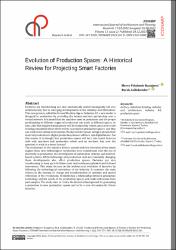| dc.contributor.author | Pekdemir Başeğmez, Merve | |
| dc.contributor.author | Asiliskender, Burak | |
| dc.date.accessioned | 2024-02-21T08:02:30Z | |
| dc.date.available | 2024-02-21T08:02:30Z | |
| dc.date.issued | 2023 | en_US |
| dc.identifier.issn | 2147-9380 | |
| dc.identifier.other | WOS:001136172000008 | |
| dc.identifier.uri | https://doi.org/10.15320/ICONARP.2023.261 | |
| dc.identifier.uri | https://hdl.handle.net/20.500.12573/1955 | |
| dc.description.abstract | Factories are transforming not only mechanically and technologically but also architecturally due to emerging developments in the industry and fabrication: This new process, called the Second Machine Age or Industry 4.0, a new model is designed in production by providing the human-machine partnership over a virtual network. It is aimed that the machines used in production and the people participating in different stages of production can work in different spaces. In time, jobs that require human power will be replaced by robots, and a new order is being considered where there will be no people in production spaces, and they can work in the virtual environment. Production for human beings is mostly from material production to digital production; labour will turn into digital labour. For this reason, it is thought that production spaces will turn into smart factories with only machines and production robots and no workers. And now the question is: what is a smart factory?The revolutions in the industry history started with the invention of the steam engine; then, new technological revolutions were experienced with the use of electricity in production, the development of automation systems and internetbased systems. While technology and production tools are constantly changing, these developments also affect production spaces. Factories are also transforming to keep up with these rapid and continuous physical and fictional innovations. This study focuses on the architectural evolution of factories by following the technological revolutions of the industry. It examines the main criteria in the process of change and transformation of factories and spatial reflections of the revolutions. It establishes a relationship between production technology and the needs of the production spaces and seeks references from past samples. The study aims to review the historical background for generating a projection to new production spaces and to be a new discussion for future factories. | en_US |
| dc.language.iso | eng | en_US |
| dc.publisher | KONYA TECHNICAL UNIV | en_US |
| dc.rights | info:eu-repo/semantics/openAccess | en_US |
| dc.subject | Factory | en_US |
| dc.subject | industrial building | en_US |
| dc.subject | industry and architecture | en_US |
| dc.subject | industry 4.0 | en_US |
| dc.subject | production space | en_US |
| dc.title | Evolution of Production Spaces: A Historical Review for Projecting Smart Factories | en_US |
| dc.type | article | en_US |
| dc.contributor.department | AGÜ, Mimarlık Fakültesi, Mimarlık Bölümü | en_US |
| dc.contributor.authorID | 0000-0003-3712-5512 | en_US |
| dc.contributor.authorID | 0000-0002-4143-4214 | en_US |
| dc.contributor.institutionauthor | Pekdemir Başeğmez, Merve | |
| dc.contributor.institutionauthor | Asiliskender, Burak | |
| dc.identifier.volume | 11 | en_US |
| dc.identifier.issue | 2 | en_US |
| dc.identifier.startpage | 716 | en_US |
| dc.identifier.endpage | 733 | en_US |
| dc.relation.journal | ICONARP INTERNATIONAL JOURNAL OF ARCHITECTURE AND PLANNING | en_US |
| dc.relation.publicationcategory | Makale - Ulusal Hakemli Dergi - Kurum Öğretim Elemanı | en_US |


















